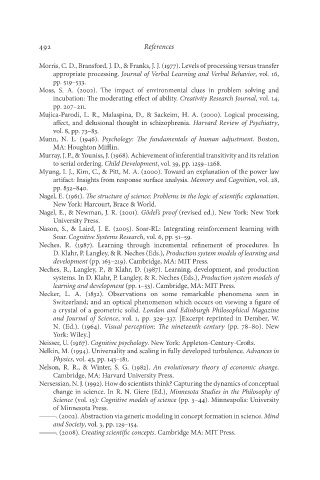Page 509 - Deep Learning
P. 509
492 References
Morris, C. D., Bransford, J. D., & Franks, J. J. (1977). Levels of processing versus transfer
appropriate processing. Journal of Verbal Learning and Verbal Behavior, vol. 16,
pp. 519–533.
Moss, S. A. (2002). The impact of environmental clues in problem solving and
incubation: The moderating effect of ability. Creativity Research Journal, vol. 14,
pp. 207–211.
Mujica-Parodi, L. R., Malaspina, D., & Sackeim, H. A. (2000). Logical processing,
affect, and delusional thought in schizophrenia. Harvard Review of Psychiatry,
vol. 8, pp. 73–83.
Munn, N. L. (1946). Psychology: The fundamentals of human adjustment. Boston,
MA: Houghton Mifflin.
Murray, J. P., & Youniss, J. (1968). Achievement of inferential transitivity and its relation
to serial ordering. Child Development, vol. 39, pp. 1259–1268.
Myung, I. J., Kim, C., & Pitt, M. A. (2000). Toward an explanation of the power law
artifact: Insights from response surface analysis. Memory and Cognition, vol. 28,
pp. 832–840.
Nagel, E. (1961). The structure of science: Problems in the logic of scientific explanation.
New York: Harcourt, Brace & World.
Nagel, E., & Newman, J. R. (2001). Gödel’s proof (revised ed.). New York: New York
University Press.
Nason, S., & Laird, J. E. (2005). Soar-RL: Integrating reinforcement learning with
Soar. Cognitive Systems Research, vol. 6, pp. 51–59.
Neches, R. (1987). Learning through incremental refinement of procedures. In
D. Klahr, P. Langley, & R. Neches (Eds.), Production system models of learning and
development (pp. 163–219). Cambridge, MA: MIT Press.
Neches, R., Langley, P., & Klahr, D. (1987). Learning, development, and production
systems. In D. Klahr, P. Langley, & R. Neches (Eds.), Production system models of
learning and development (pp. 1–53). Cambridge, MA: MIT Press.
Necker, L. A. (1832). Observations on some remarkable phenomena seen in
Switzerland; and an optical phenomenon which occurs on viewing a figure of
a crystal of a geometric solid. London and Edinburgh Philosophical Magazine
and Journal of Science, vol. 1, pp. 329–337. [Excerpt reprinted in Dember, W.
N. (Ed.). (1964). Visual perception: The nineteenth century (pp. 78–80). New
York: Wiley.]
Neisser, U. (1967). Cognitive psychology. New York: Appleton-Century-Crofts.
Nelkin, M. (1994). Universality and scaling in fully developed turbulence. Advances in
Physics, vol. 43, pp. 143–181.
Nelson, R. R., & Winter, S. G. (1982). An evolutionary theory of economic change.
Cambridge, MA: Harvard University Press.
Nersessian, N. J. (1992). How do scientists think? Capturing the dynamics of conceptual
change in science. In R. N. Giere (Ed.), Minnesota Studies in the Philosophy of
Science (vol. 15): Cognitive models of science (pp. 3–44). Minneapolis: University
of Minnesota Press.
———. (2002). Abstraction via generic modeling in concept formation in science. Mind
and Society, vol. 3, pp. 129–154.
———. (2008). Creating scientific concepts. Cambridge MA: MIT Press.

